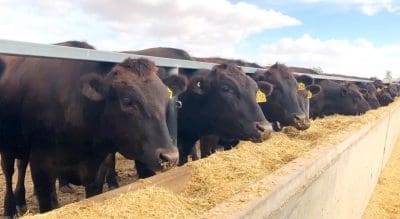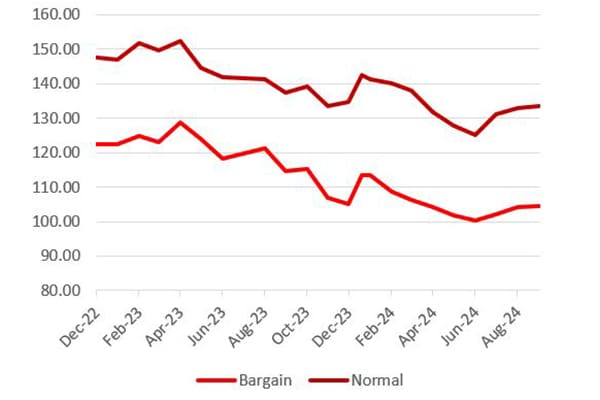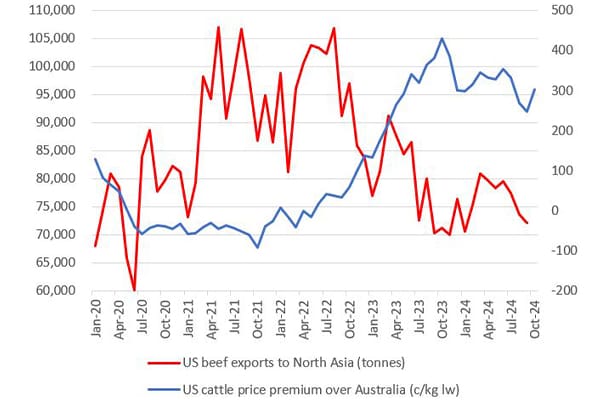THERE has been a further narrowing in feeder premiums for Wagyu, Wagyu cross and Angus cattle over the past month, Elders has noted in its latest December monthly livestock bulletin released yesterday.
The trend is associated with a contraction in demand for higher-priced beef items owing to a slowing in the Chinese market, contraction in the food service sector, a shift in buying habits in Japan and cost of living pressures the world over, analyst Richard Koch said in the report.
 Since the start of 2023, Wagyu sirloin prices in the US market have fallen 9-14 percent, in sharp contrast with a 38pc rise in manufacturing beef prices over the same period, Elders said.
Since the start of 2023, Wagyu sirloin prices in the US market have fallen 9-14 percent, in sharp contrast with a 38pc rise in manufacturing beef prices over the same period, Elders said.
The fall in US Wagyu beef prices is consistent across the range of cuts (sirloin, round, chuck, brisket) measured by the USDA’s Market Reporting Service.
“Falling premium beef prices are showing up in a narrowing in the feeder cattle premiums for Angus, Wagyu cross and Wagyu,” Mr Koch said in the report.
“Angus feeder premiums (over flatbacks) have narrowed from around 40c/kg to just 9c/kg, while indications are that the normal F1 Wagyu feeder premium of $2/kg has halved, while Purebred Wagyu feeder premiums of $5-6/kg lw have done about the same, although it is a little difficult to be too definitive about specific margins given the wide range of quality considerations.”
In one example provided in the report, Elders national livestock manager Peter Homann said he had just bought a barge-full of black EU-eligible steers in the south for less than what buyers were paying for Brahman feeders in Central Queensland.
Also working against the premium cattle market was the extended length of time on feed, cost of financing the cattle and the risk that high-end beef demand continues to contract through the feeding period, Elders said.
Some NSW and Queensland lotfeeders have moved part of their inventory away from longfed Wagyu to focus on shorter fed cattle that can be turned over more frequently, negating some of the risk of lotfeeding, Mr Koch said.

This chart shows the bargain and normal Japanese retail beef prices for Wagyu sirloin (Ac/kg). Source: USDA.
Prices for Wagyu beef have been falling over the past year, counter to the trend in manufacturing beef prices.
Cost of living pressures the world over is seeing consumers trade down on beef purchases.
Christmas wind-down looms
In other topics raised in Elders latest livestock report, it says local cattle markets look set to remain mixed over coming weeks as the industry winds down for Christmas/New Year.
Queensland has another two full weeks of processing left with most plants planning to close around 19 December and likely remain closed until at least the second week of January. In the south, processing schedules will be affected by holidays falling mid-week. Expect southern prices to remain depressed as processors work through pre-Christmas bookings on reduced capacity due to the holiday schedule, Elders said.
“We’re getting pretty good rains now, but still it’s been dry. Prices have come back, works are fully booked, and we’re coming into that Christmas period where it can be tough to sell stock. But everyone’s talking positively about next year with processors offering contracts going out into the New Year,” national livestock manager Peter Homann said.
Looking forward to the New Year, Elders agents report that processors are upbeat about prospects for meat contracts and prices as industry processing capacity moves back into full swing from mid-January. The major caveat to a resumption in the positive cattle price trend would seem to come from US trade policy and its impact on Australia’s trading partners.
Outside of the US, Australian beef continues to sell well aided by the large differential between Australian and US cattle values which has made Australian beef more competitive. US beef exports to Asia are down 6pc on last year but down 22pc compared to 2022 with much of this business shifting to Australia.
This chart shows US beef exports to Asia vs the US cattle price premium compared to Australia cattle values.

Source: USDA & MLA.
Higher US cattle prices have opened the door for increased Australian beef exports into Asia.
While national saleyard cattle price indicators are stable, they belie some significant shifts happening across the states. The strong start to the northern wet season that has delivered good rain to NSW and Queensland has seen cattle prices start to firm across northern markets by 20c/kg lw.
The rain has convinced some producers to hold stock back for kills early next year with the promise of extra weight, which has tightened nearby supplies. Assisting the lift in prices has been an increase in live export buying activity across Queensland as NT pastoral cattle supplies are finished and cattle on the NT floodplain are not ready.
Exporters are racing to send cattle to Indonesia while they have valid export permits (they expire at year’s end) and so they can be put on feed to be ready for Ramadan at the end of March.
